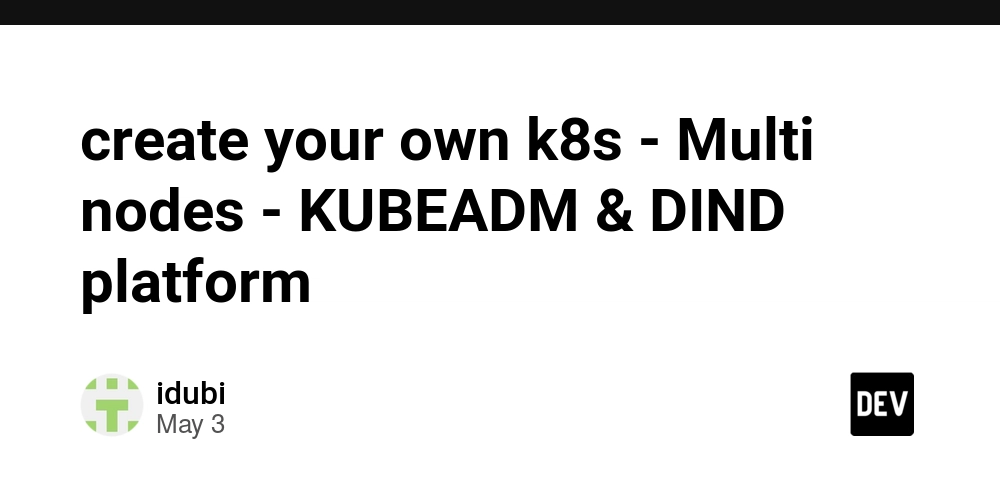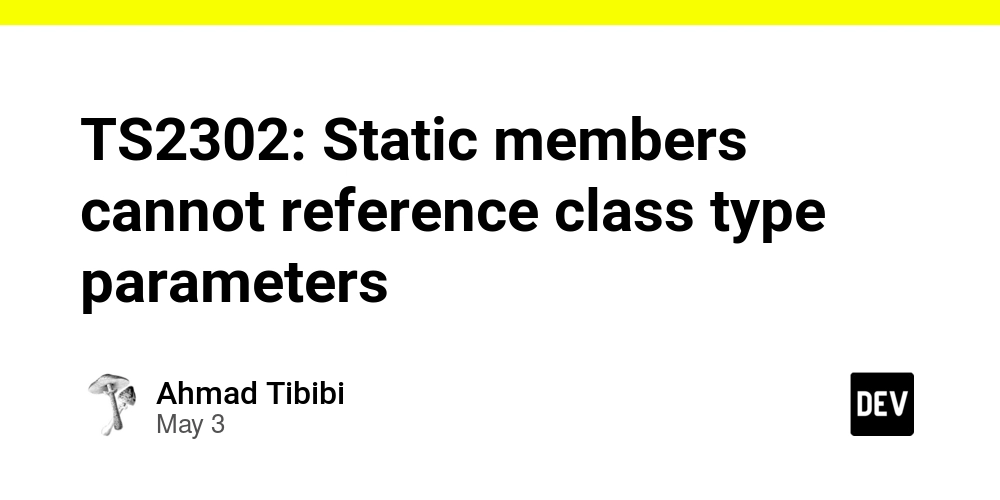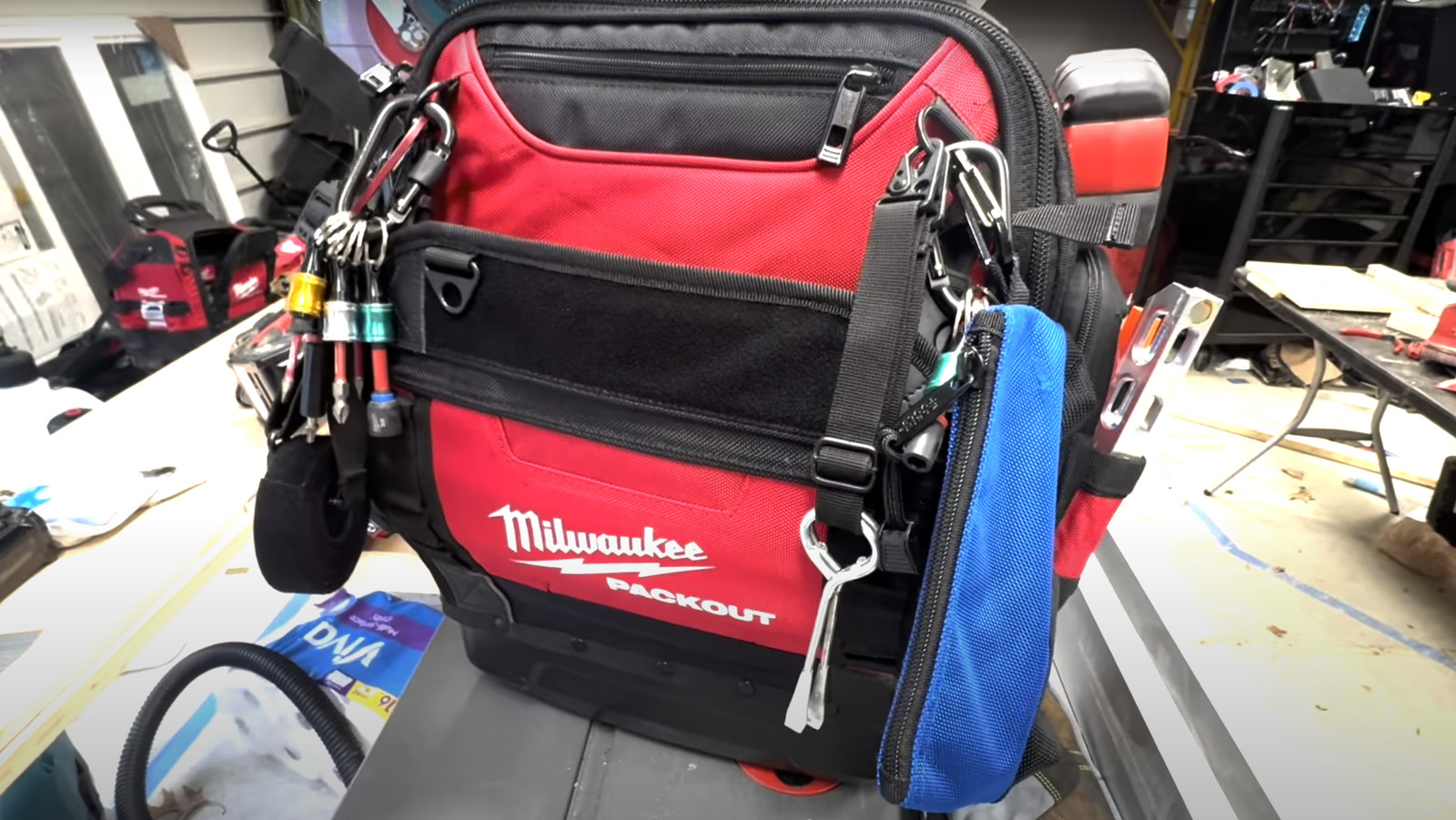create your own k8s - Multi nodes - KUBEADM & DIND platform
Create Your Own K8s Multi-Node Platform – KUBEADM & DIND 40 Days of K8s – CKA Challenge (06/40) @piyushsachdeva Day 6/40 - Kubernetes Multi Node Cluster Setup Step By Step | Kind Tutorial In this post, I demonstrate two architectures I used to create a functioning multi-node Kubernetes environment. This environment serves as a sandbox for upcoming lessons. The two environments are based on different architectures: 1. Containerized architecture – using the KIND Kubernetes provider over Docker 2. VM-based architecture – using a fully functioning KUBEADM setup 1. KIND: Containerized Architecture (KIND over Docker) Prerequisites: Golang > 1.6 sudo apt install golang-go Docker (already installed) kubectl – Kubernetes CLI # 1. Download the latest version curl -LO "https://dl.k8s.io/release/$(curl -L -s https://dl.k8s.io/release/stable.txt)/bin/linux/amd64/kubectl.sha256" # 2. Install kubectl sudo install -o root -g root -m 0755 kubectl /usr/local/bin/kubectl # 3. Test the installation kubectl version --client Installation: KIND: # For AMD64 / x86_64 [ $(uname -m) = x86_64 ] && curl -Lo ./kind https://kind.sigs.k8s.io/dl/v0.27.0/kind-linux-amd64 # For ARM64 [ $(uname -m) = aarch64 ] && curl -Lo ./kind https://kind.sigs.k8s.io/dl/v0.27.0/kind-linux-arm64 chmod +x ./kind sudo mv ./kind /usr/local/bin/kind Create a Cluster: You can create a cluster either by running a single-node setup: kind create cluster --image kindest/node:v1.32.2@sha256:f226345927d7e348497136874b6d207e0b32cc52154ad8323129352923a3142f --name cka-cluster-1 Or by preparing a YAML configuration for a multi-node setup: 1. Create a YAML file describing the cluster: kind: Cluster apiVersion: kind.x-k8s.io/v1alpha4 nodes: - role: control-plane - role: control-plane - role: worker - role: worker - role: worker - role: worker 2. Create the cluster using the YAML file: kind create cluster --image kindest/node:v1.32.2@sha256:f226345927d7e348497136874b6d207e0b32cc52154ad8323129352923a3142f --name cka-cluster-2 --config kind-2master-4workers Verify the Created Cluster: After creating the cluster, validate its configuration using the kubectl CLI: kubectl config get-clusters kubectl config get-users Docker View of KIND Nodes: Since KIND uses Docker under the hood, each Kubernetes node is represented as a Docker container. Switching context via kubectl config use-context will show the corresponding containers becoming active: docker ps Example output: CONTAINER ID IMAGE ... NAMES 16462509a712 kindest/haproxy:... ... cka-cluster-2-external-load-balancer 4016000812c4 kindest/node:... ... cka-cluster-2-control-plane2 ... Common Commands: kubectl config current-context kubectl get nodes kubectl config use-context kind-cka-cluster-1 kubectl get nodes 2. VM-Based Architecture – KUBEADM Kubernetes Using VAGRANT The VM architecture differs from Docker: Each VM is a full OS instance acting as a node (master or worker). The general flow: Install Kubeadm on the main master node and run kubeadm init. Create a token to allow other nodes to join. Other nodes (including additional masters) join using this token. I used Vagrant to automate both VM creation and the Kubeadm setup process. 1. VM Setup You need a VM platform like VirtualBox, VMware, or Hyper-V that supports Vagrant. Folder structure: k8s-vmware-cluster/ ├── Vagrantfile ├── common.sh ├── master.sh ├── worker.sh └── disable-swap.sh 2. Vagrant Installation Ensure you're running on a system with a hypervisor (macOS, Windows, Linux). Do not run Vagrant-based VMs on WSL. Install Vagrant: Follow Vagrant installation instructions For VMware users: Install the vagrant-vmware-desktop plugin 3. Vagrantfile – VM Orchestration Each VM is provisioned with common resources and then initialized using shell scripts. Master Node: config.vm.define "master-node" do |node_config| node_config.vm.hostname = "master-node" node_config.vm.network "private_network", ip: "192.168.56.10" node_config.vm.provision "shell", path: "common.sh" node_config.vm.provision "shell", path: "master.sh" node_config.vm.provision "shell", path: "disable-swap.sh", run: "always" end In master.sh, the following happens: Runs kubeadm init Generates the join.sh script containing the token Other nodes will use this script to join the cluster Worker Node: config.vm.define "worker-node-1" do |node_config| node_config.vm.hostname = "worker-node-1" node_config.vm.network "private_network", ip: "192.168.56.11" node_config.vm.provision "shell", path: "common.sh" node_config.vm.provision

Create Your Own K8s Multi-Node Platform – KUBEADM & DIND
40 Days of K8s – CKA Challenge (06/40)
Day 6/40 - Kubernetes Multi Node Cluster Setup Step By Step | Kind Tutorial
In this post, I demonstrate two architectures I used to create a functioning multi-node Kubernetes environment.
This environment serves as a sandbox for upcoming lessons.
The two environments are based on different architectures:
1. Containerized architecture – using the KIND Kubernetes provider over Docker
2. VM-based architecture – using a fully functioning KUBEADM setup
1. KIND: Containerized Architecture (KIND over Docker)
Prerequisites:
-
Golang > 1.6
sudo apt install golang-go Docker (already installed)
-
kubectl– Kubernetes CLI
# 1. Download the latest version curl -LO "https://dl.k8s.io/release/$(curl -L -s https://dl.k8s.io/release/stable.txt)/bin/linux/amd64/kubectl.sha256" # 2. Install kubectl sudo install -o root -g root -m 0755 kubectl /usr/local/bin/kubectl # 3. Test the installation kubectl version --client
Installation:
-
KIND:
# For AMD64 / x86_64 [ $(uname -m) = x86_64 ] && curl -Lo ./kind https://kind.sigs.k8s.io/dl/v0.27.0/kind-linux-amd64 # For ARM64 [ $(uname -m) = aarch64 ] && curl -Lo ./kind https://kind.sigs.k8s.io/dl/v0.27.0/kind-linux-arm64 chmod +x ./kind sudo mv ./kind /usr/local/bin/kind
Create a Cluster:
-
You can create a cluster either by running a single-node setup:
kind create cluster --image kindest/node:v1.32.2@sha256:f226345927d7e348497136874b6d207e0b32cc52154ad8323129352923a3142f --name cka-cluster-1 -
Or by preparing a YAML configuration for a multi-node setup:
1. Create a YAML file describing the cluster:
kind: Cluster apiVersion: kind.x-k8s.io/v1alpha4 nodes: - role: control-plane - role: control-plane - role: worker - role: worker - role: worker - role: worker2. Create the cluster using the YAML file:
kind create cluster --image kindest/node:v1.32.2@sha256:f226345927d7e348497136874b6d207e0b32cc52154ad8323129352923a3142f --name cka-cluster-2 --config kind-2master-4workers
Verify the Created Cluster:
After creating the cluster, validate its configuration using the kubectl CLI:
kubectl config get-clusters
kubectl config get-users
Docker View of KIND Nodes:
Since KIND uses Docker under the hood, each Kubernetes node is represented as a Docker container. Switching context via kubectl config use-context will show the corresponding containers becoming active:
docker ps
Example output:
CONTAINER ID IMAGE ... NAMES
16462509a712 kindest/haproxy:... ... cka-cluster-2-external-load-balancer
4016000812c4 kindest/node:... ... cka-cluster-2-control-plane2
...
Common Commands:
kubectl config current-context
kubectl get nodes
kubectl config use-context kind-cka-cluster-1
kubectl get nodes
2. VM-Based Architecture – KUBEADM Kubernetes Using VAGRANT
The VM architecture differs from Docker:
Each VM is a full OS instance acting as a node (master or worker).
The general flow:
- Install Kubeadm on the main master node and run
kubeadm init. - Create a token to allow other nodes to join.
- Other nodes (including additional masters) join using this token.
I used Vagrant to automate both VM creation and the Kubeadm setup process.
1. VM Setup
You need a VM platform like VirtualBox, VMware, or Hyper-V that supports Vagrant.
Folder structure:
k8s-vmware-cluster/
├── Vagrantfile
├── common.sh
├── master.sh
├── worker.sh
└── disable-swap.sh
2. Vagrant Installation
Ensure you're running on a system with a hypervisor (macOS, Windows, Linux).
Do not run Vagrant-based VMs on WSL.
Install Vagrant:
Follow Vagrant installation instructionsFor VMware users:
Install the vagrant-vmware-desktop plugin
3. Vagrantfile – VM Orchestration
Each VM is provisioned with common resources and then initialized using shell scripts.
Master Node:
config.vm.define "master-node" do |node_config|
node_config.vm.hostname = "master-node"
node_config.vm.network "private_network", ip: "192.168.56.10"
node_config.vm.provision "shell", path: "common.sh"
node_config.vm.provision "shell", path: "master.sh"
node_config.vm.provision "shell", path: "disable-swap.sh", run: "always"
end
In master.sh, the following happens:
- Runs
kubeadm init - Generates the
join.shscript containing the token - Other nodes will use this script to join the cluster
Worker Node:
config.vm.define "worker-node-1" do |node_config|
node_config.vm.hostname = "worker-node-1"
node_config.vm.network "private_network", ip: "192.168.56.11"
node_config.vm.provision "shell", path: "common.sh"
node_config.vm.provision "shell", path: "worker.sh"
node_config.vm.provision "shell", path: "disable-swap.sh", run: "always"
end
- The worker script waits for
join.shto be generated by the master and then executes it.
# Wait for join.sh
for i in {1..30}; do
if [ -f /vagrant/join.sh ]; then
break
fi
echo "[$(date '+%T')] Waiting for /vagrant/join.sh... (try $i/30)"
sleep 10
if [ "$i" == "30" ]; then
echo "Timeout waiting for /vagrant/join.sh"
exit 1
fi
done
SWAP Management:
Kubernetes requires swap to be disabled.
Even though common.sh disables swap on boot, VM restarts may re-enable it.
Ensure swap is disabled always:
node_config.vm.provision "shell", path: "disable-swap.sh", run: "always"
Summary
Both KIND and KUBEADM architectures achieve the same goal with different approaches:
KIND:
- Simple and fast
- Uses Docker containers
- Best for development or sandbox use
KUBEADM on VMs:
- Production-grade realism
- Full control over networking, bootstrapping, and configuration
- Greater complexity and overhead
Both setups follow a similar underlying flow:
- crations of master node
- + container-D
- + contrl plan components
- + kubeadm & kubeproxy (since the control plan components are executed inside pods after all ...)
- creation of worker nodes
- + container-D
- + kubeproxy + kubeadm (since this are the worker node processes )
- join the workers to the master by using kubeadm join (with the master token generated at master process)







































































































































































![[The AI Show Episode 145]: OpenAI Releases o3 and o4-mini, AI Is Causing “Quiet Layoffs,” Executive Order on Youth AI Education & GPT-4o’s Controversial Update](https://www.marketingaiinstitute.com/hubfs/ep%20145%20cover.png)





























































































































![[FREE EBOOKS] Learn Computer Forensics — 2nd edition, AI and Business Rule Engines for Excel Power Users & Four More Best Selling Titles](https://www.javacodegeeks.com/wp-content/uploads/2012/12/jcg-logo.jpg)





![From Art School Drop-out to Microsoft Engineer with Shashi Lo [Podcast #170]](https://cdn.hashnode.com/res/hashnode/image/upload/v1746203291209/439bf16b-c820-4fe8-b69e-94d80533b2df.png?#)









































































































(1).jpg?#)






























_Inge_Johnsson-Alamy.jpg?width=1280&auto=webp&quality=80&disable=upscale#)












































































































![AirPods 4 On Sale for $99 [Lowest Price Ever]](https://www.iclarified.com/images/news/97206/97206/97206-640.jpg)

![Apple Developing AI 'Vibe-Coding' Assistant for Xcode With Anthropic [Report]](https://www.iclarified.com/images/news/97200/97200/97200-640.jpg)
![Apple's New Ads Spotlight Apple Watch for Kids [Video]](https://www.iclarified.com/images/news/97197/97197/97197-640.jpg)
































































































